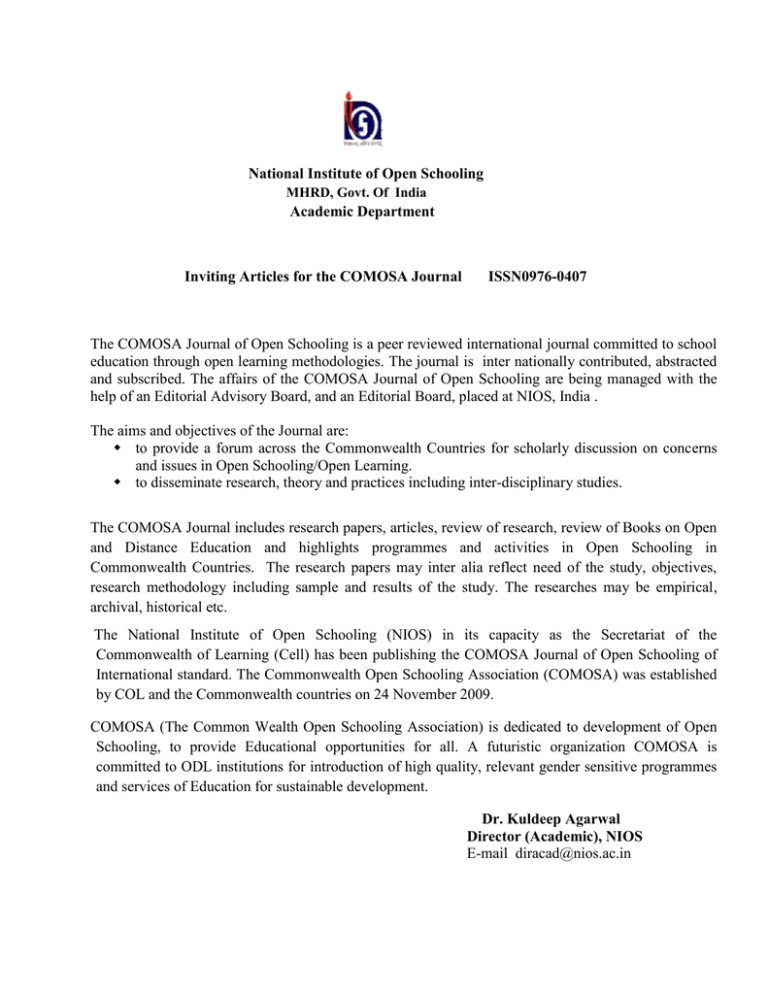Inviting Articles for the COMOSA Journal (32 KB)
advertisement

National Institute of Open Schooling MHRD, Govt. Of India Academic Department Inviting Articles for the COMOSA Journal ISSN0976-0407 The COMOSA Journal of Open Schooling is a peer reviewed international journal committed to school education through open learning methodologies. The journal is inter nationally contributed, abstracted and subscribed. The affairs of the COMOSA Journal of Open Schooling are being managed with the help of an Editorial Advisory Board, and an Editorial Board, placed at NIOS, India . The aims and objectives of the Journal are: to provide a forum across the Commonwealth Countries for scholarly discussion on concerns and issues in Open Schooling/Open Learning. to disseminate research, theory and practices including inter-disciplinary studies. The COMOSA Journal includes research papers, articles, review of research, review of Books on Open and Distance Education and highlights programmes and activities in Open Schooling in Commonwealth Countries. The research papers may inter alia reflect need of the study, objectives, research methodology including sample and results of the study. The researches may be empirical, archival, historical etc. The National Institute of Open Schooling (NIOS) in its capacity as the Secretariat of the Commonwealth of Learning (Cell) has been publishing the COMOSA Journal of Open Schooling of International standard. The Commonwealth Open Schooling Association (COMOSA) was established by COL and the Commonwealth countries on 24 November 2009. COMOSA (The Common Wealth Open Schooling Association) is dedicated to development of Open Schooling, to provide Educational opportunities for all. A futuristic organization COMOSA is committed to ODL institutions for introduction of high quality, relevant gender sensitive programmes and services of Education for sustainable development. Dr. Kuldeep Agarwal Director (Academic), NIOS E-mail diracad@nios.ac.in Note for Contributors The articles for COMOSA Journal of Open Schooling should provide useful information about Open Schooling System. In order to ensure the quality and standard of the articles/papers, the received articles/papers are reviewed by a panel of experts in the field of open and distance education and only the selected articles/ papers are considered for publication in the journal. If the article is print worthy with certain modifications, the author may be asked to do the needful. Format of the Paper/Article/Research Report for COMOSA Journal Depending upon the nature of contribution, the following formats may be followed: a) 1. 2. 3. 4. 5. 6. 7. 8. 9. Articles/Papers in Open and Distance Learning (ODL) Abstract, Keywords (in about 100-150 words in a separate page (A-4 size). Title Author’s Name, Address in the footnote of the first page. Introduction/Context Sub-items with headings relating to: - Field Situations/Scenario - Emerging Issues, sub issues - Critical analysis Innovative initiatives to address the problems, implications for ODL in the country’s context/context of other countries, action points (if any) Conclusion Acknowledgements (if any). References in single space (the detailed about format is given separately) b) Case Study Reports in Open and Distance Learning (ODL) 1. Abstract, Keywords (in about 100-150 words in a separate page (A-4 size). 2. Title 3. Author/Name of Institution/Organisation/Country/Year of study in the footnote of the first page. 4. Introduction/Context 5. Objectives 6. Description of the case, methodology, quantitative/qualitative aspects, critical analysis, comparison of the case study with other countries in the concerned area. 7. Special Features/Innovative Initiatives/Success Points 8. Conclusion – Implication and needed follow up, replicability, 9. Acknowledgements (if any) 10. Reference c) Research Papers in Open and Distance Learning (ODL) 1. Abstract, Keywords (in about 100-150 words in a separate A4 size) paper 2. Title 3. Authors name, address in the foot-note of the first page. 4. Introduction (Context/Rationale, year of study, Institute/ University including country/countries) 5. 6. 7. 8. 9. Objectives of the Study Sample Size, Sampling Technique Study Tools Methodology Results (data processing, analytical presentation including statistical treatment, quantitative and qualitative analysis, tables, diagrams, graphs with captions). 10. Conclusion - major findings, implications, needed follow-up action, suggestion for further research in the area. 11. Acknowledgements (if necessary) 12. References in single space (Details about Format given separately). References A reference list should contain only references that are cited in the text. For maintaining a standard for writing references to a book, chapter in a book, article from a journal following style should be followed: For books : Bobrow, D.G., & Collins, A.M. (Eds.), (1975). Representation and understanding: Studies in cognitive science, New York: Academic Press. For articles : Frase, I.T. (1968). Questions as aids to reading: Some research and a theory. American Educational Research Journal, 5, 319-322. If the reference is a policy document of any Government/International Document, it should be written as follows: Commonwealth Secretariat (2000) Education in a Global Era: Challenges to Equity, Opportunities for Diversity-Issue Paper, London. Fourteenth Conference of Commonwealth Education Ministers, Halifax, Nova Scotia, Canada, November 2000. Title of Books/Journals should not be abbreviated and it should be in italics. Length of the Research Paper/Articles etc. Research Paper : 3500-7000 words, Article : 3500-7000 words, Book Review : About 2000 words, Research Review : About 2000 words Kindly send Articles/Reports in A-4 size bond paper with appropriate margin along with a floppy (in MS-Word or Page Maker format) or through E-mail comosa@nios.ac.in , aochem@nios.ac.in Editorial Correspondence All communications related to publications should be addressed to: The Chief Editor, COMOSA Journal of Open Schooling, National Institute of Open Schooling, A24/25, Institutional Area, Sector-62, NOIDA-201309, Uttar Pradesh (India)


